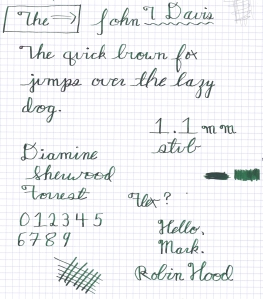
Conklin Crescent 1.1 mm factory stub faux-flex sample. Let me stress that I’m not so egotistical that I think people need to spell my name with a “the;” that just sort of happened that way.
Confession time: I’ve never been entirely thrilled with how my handwriting looks with a stub nib. Most people love them for the line variation–and I certainly love looking at other people’s gorgeous writing samples using stubs–but unless I’m doing outright horizontal and vertical strokes, I’ve always felt like I’m not accomplishing much more than I would with a bold/double bold regular nib. I’ve always wondered if it was because I was left handed or just because I was doing something wrong, but suffice it to say I’ve been quietly experimenting for a while with my Pendleton Point to try to get better results.
After watching hours of Stephen Brown‘s fountain pen videos (most all of which include examples of his amazing handwriting and nib flexing technique), I decided to try to emulate the way he did his capital “H.” It’s super classy and a lot nicer than the way I’ve done mine for almost 20 years, and as a bonus can be done without lifting the pen from the paper, which makes for a nicer looking result overall.
(That is to say, the way I’ve been making my H’s up to now has been inconsistent, and, well, hideous.)
You can see my attempt at Mr Brown’s H in the sample to the right–among other things.
It’s often said that you make your most interesting discoveries while you’re looking for something else. After staring at Mr Brown’s for a while, I realized the only way to do it with a stub nib would be the following. My apologies if this is a bit muddled. I had some trouble putting in words exactly what I was doing.
- On the initial downstroke, Angle the nib fully perpendicular to the top edge of the paper on the downstroke (that is, the nib tip should point straight at the paper’s top edge at all times) to get the widest line;
- Without lifting the pen from the paper or stopping, move through any cross-stroke with nib shifted to position (1), and then, without stopping, quickly rotate my grip on the pen on the upstroke so that I’m writing on the edge of the stub nib, thus getting a much thinner line;
- Without stopping, at the peak of an upstroke rotate the pen back to position (1) for the next downstroke or cross-stroke; and
- Repeat.
(The easiest way to figure out if you’re doing this right is to attempt a series of interconnected lower-case L’s. If they look like they were made with a flex nib, you’ve got it.)
Once I’d pulled off an H doing this, I noticed the line variation was extreme enough that it looked like flexible nib writing. That got me interested enough to keep practicing, eventually resulting in the writing sample to the right. Of course, I went through 3-4 sheets to get the technique down to something that looked like that. I’m extremely pleased with the results you get using the pen this way, though there are some caveats.
- Occasionally, you’ll need to lift the pen from the paper to get the thinnest possible line/cleanest line going forward. I found this necessary on m’s and n’s after each downstroke, for example.
- You’ve got to be very careful not to press down on the nib during the upstroke, when the nib is effectively on its side. This seems like a great way to misalign the tines if you screw up. Seriously, if someone is reading this and thinks I’m doing something horribly stupid to my pen, please let me know in the comments.
- You’ve got to maintain a pretty good speed when you do this. Move too slow and not only will the writing look shaky (since you’re writing with only part of the nib), but you’re likely to run out of ink on long upstrokes, since the nib isn’t in full contact and thus the capillary action keeping the nib wet is momentarily stopped. You’re just writing with whatever you had on the nib when the upstroke started. I think. I’m not entirely sure that’s what’s happening, but I do know you’ll run out of ink if you move too slow.
- Since the line variation depends on how much you rotate the pen, it takes some practice to consistently rotate the nib every time. If you look close at the sample above, you’ll surely notice some inconsistency.
- All these instructions are based on left-handed writing. If you’re right handed you might have to tweak it a bit. I’m not sure. I can’t write with my right hand at all, so I can’t really experiment.
I tried this with a 0.9 mm Pendleton Point Stub Italic as well (actually the pen I was using when I figured out how to do this). The stub-italic has sharper corners than a regular stub (for crisper writing). That means the edges are sharper and while you can thus get even thinner lines on the upstroke, it’s also harder to do–there’s less residual ink on the nib when you rotate it, and the sharp edge is more likely to scratch the paper as opposed to, y’know, writing.
So my recommendation if you want to try this would be to use a regular no-frills stub, the bigger the better–but not so big you can’t control it. A bigger stub will put more ink in play, which means you’ll have more to work with on the upstroke, and it’ll be more forgiving than an italic/quasi-italic nib about being rotated.
Thoughts? Has anyone else tried this?





